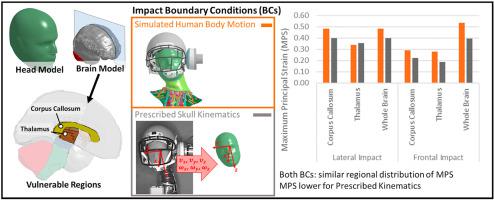Journal of the Mechanical Behavior of Biomedical Materials ( IF 3.3 ) Pub Date : 2021-01-05 , DOI: 10.1016/j.jmbbm.2020.104299 David A. Bruneau , Duane S. Cronin

|
Computational human body models (HBM) present a novel approach to predict brain response in football impact scenarios, with prescribed kinematic boundary conditions for the HBM skull typically used at present. However, computational optimization of helmets requires simulation of the coupled helmet and HBM model; which is much more complex and has not been assessed in the context of brain deformation and existing simplified approaches. In the current study, two boundary conditions and the resulting brain deformations were compared using a HBM head model: (1) a prescribed skull kinematics (PK) boundary condition using measured head kinematics from experimental impacts; and (2) a novel detailed simulation of a HBM head and neck, helmet and linear impactor (HBM-S). While lateral and rear impacts exhibited similar levels of maximum principal strain (MPS) in the brain tissue using both boundary conditions, differences were noted in the frontal orientation (at 9.3 m/s, MPS was 0.39 for PK, 0.54 for HBM-S). Importantly, both PK and HBM-S boundary conditions produced a similar distribution of MPS throughout the brain for each impact orientation considered. Within the corpus callosum and thalamus, high MPS was associated with lateral impacts and lower values with frontal and rear impacts. The good correspondence of both boundary conditions is encouraging for future optimization of helmet designs. A limitation of the PK approach is the need for experimental head kinematics data, while the HBM-S can predict brain response for varying impact conditions and helmet configurations, with potential as a tool to improve helmet protection performance.
中文翻译:

处方颅骨运动学和模拟橄榄球头盔撞击边界条件的计算头部模型的大脑反应
计算人体模型(HBM)提出了一种新颖的方法来预测足球撞击场景中的大脑反应,并为目前通常使用的HBM头骨规定了运动学边界条件。但是,头盔的计算优化需要对头盔和HBM耦合模型进行仿真。这要复杂得多,并且尚未在脑变形和现有简化方法的背景下进行评估。在当前的研究中,使用HBM头部模型比较了两个边界条件和由此产生的大脑变形:(1)使用从实验冲击中测得的头部运动学来确定处方的颅骨运动学(PK)边界条件;(2)HBM头颈部,头盔和线性撞击器(HBM-S)的新颖详细模拟。尽管在两种边界条件下,侧面和背面碰撞在脑组织中均表现出相似的最大主应变(MPS)水平,但在额向方向上存在差异(9.3 m / s,PK的MPS为0.39,HBM-S的MPS为0.54) 。重要的是,对于所考虑的每个撞击方向,PK和HBM-S边界条件在整个大脑中都产生了类似的MPS分布。在call体和丘脑内,高MPS与侧向撞击相关,而较低的值与正面和背面撞击相关。两种边界条件的良好对应关系为头盔设计的未来优化提供了鼓励。PK方法的局限性是需要实验性的头部运动学数据,而HBM-S可以预测各种冲击条件和头盔配置对大脑的反应,











































 京公网安备 11010802027423号
京公网安备 11010802027423号